
U.S. Department of Transportation
Federal Highway Administration
1200 New Jersey Avenue, SE
Washington, DC 20590
202-366-4000

In Every Day Counts (EDC) rounds three and four, use of ultra-high performance concrete (UHPC) quadrupled from 50 bridges in a dozen States to more than 200 structures nationwide. In most cases UHPC was used to create simple, strong, long-lasting connections for prefabricated bridge elements (PBEs).
UHPC is a steel fiber-reinforced, portland cement-based material that delivers performance far exceeding that of conventional concrete. Built offsite and moved to the project location for installation, PBEs shorten onsite construction time, enhance safety, and offer superior durability. Field-cast UHPC creates connections between PBEs that use less concrete and provide better long-term performance than typical connections.
The Federal Highway Administration recognized UHPC's potential in the early 2000s and conducted research to develop deployable solutions that make the best use of the technology. "UHPC is a combination of lots of advancements that have occurred in the field of concrete," said Benjamin Graybeal, bridge engineering research team leader in FHWA's Office of Infrastructure Research and Development.
The EDC UHPC team promoted the technology as an option for connecting PBEs by offering technical assistance and training, including peer exchanges, webinars, and workshops in 33 States. The number of agencies demonstrating, assessing, or using the technology as a standard practice increased from 12 in January 2015 to 33 in December 2018.
"Our workshops were particularly effective in explaining this technology," said Mark Leonard, FHWA Resource Center structural engineer and EDC UHPC team coordinator. "The workshops got a lot of people thinking more seriously about UHPC's potential to improve performance on their projects."
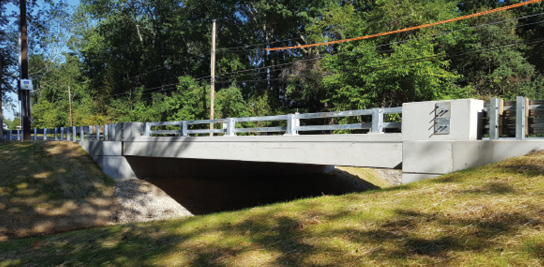
The Delaware Department of Transportation combined precast elements with UHPC connections and a UHPC overlay on an Accelerated Innovation Deployment Demonstration project. Credit: Delaware Department of Transportation
In addition to deploying the technology on bridge projects, agencies developed use standards and launched research on UHPC materials and applications to add to the highway community's knowledge base.
The agency with the most prolific use of the technology is the New York State Department of Transportation (NYSDOT), which incorporated UHPC into 76 bridges. In addition to connecting deck panels, girders, beams, superstructure units, and substructure columns with UHPC, NYSDOT pioneered the use of UHPC link slabs to connect bridge decks across expansion joint locations and improve bridge durability. The agency also developed specifications for field-cast UHPC connections and overlays that other DOTs used as guides in drafting their own specifications.
The Iowa Department of Transportation (DOT) and its partners used UHPC girders on the Mars Hill Bridge completed in Wapello County in 2006, the Nation's first highway project using UHPC. Iowa's project in Buchanan County in 2016 was the first to apply a UHPC overlay to extend the life of a deteriorated bridge deck and minimize future maintenance costs.
Another early adopter, the Pennsylvania Department of Transportation used UHPC on 30 bridges and developed UHPC PBE connection standards. The Washington State Department of Transportation outlined standards for deck bulb-tee girders with UHPC connections. California Department of Transportation seismic research led to development of UHPC connection and precast column designs to enhance bridge resiliency.
After building Idaho's first bridge with UHPC connections in 2016, the Idaho Transportation Department (ITD) rapidly became a frequent user of the technology, completing 20 bridges. ITD connected precast concrete slab deck beams with UHPC on a dozen small bridge replacements, relying on the technology to provide more durable structures with longer service lives.
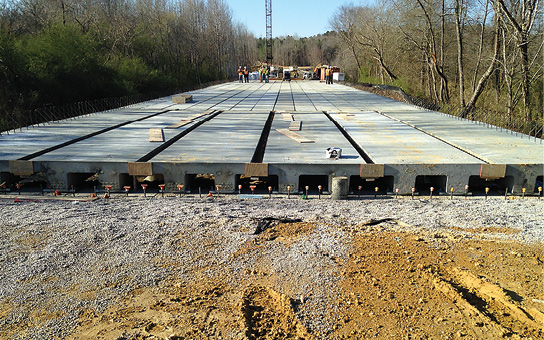
The South Carolina Department of Transportation evaluated the use of three types of beams with UHPC connections on a Kershaw County bridge project. Credit: South Carolina Department of Transportation
The Delaware Department of Transportation (DelDOT) completed the country's second bridge deck overlay using UHPC on a New Castle County project, which also used UHPC to connect adjacent box girders. By combining these innovations on the Accelerated Innovation Deployment Demonstration project, DelDOT expects the bridge to provide a 100-year design life.
New Jersey's 3.5-mile-long Pulaski Skyway deck replacement featured precast deck panels connected with UHPC, stainless steel rebar, and a polyester concrete overlay to maximize durability. The New Jersey Department of Transportation chose this system to minimize future repairs and traffic disruption on the bridge, which carries 67,000 vehicles a day. Using 5,000 cubic yards of UHPC to connect 1 million square feet of deck panels, the project is the largest application of UHPC to date and serves as an example for other agencies.
The South Carolina Department of Transportation (SCDOT) tried different types of precast concrete deck beams and UHPC connections on a Kershaw County bridge replacement.
SCDOT constructed one bridge span with double-tee deck beams, two with hollow core slab deck beams, and one with solid slab deck beams. SCDOT and Clemson University are monitoring bridge performance and will produce a report to share findings and inform decision making on future projects.
Consult Design and Construction of UHPC Field-Cast Connections for FHWA's latest guide on using UHPC connections.
Review a checklist of items to consider when developing inspection procedures for UHPC connections.
Explore the many ways States use UHPC on bridge projects on an interactive map.
Contact Benjamin Graybeal of the FHWA Turner-Fairbank Highway Research Center or Mark Leonard of the FHWA Resource Center for information and technical assistance.
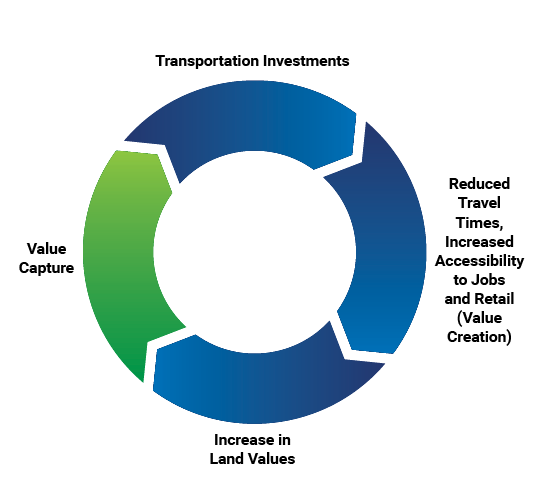
Value capture harnesses a portion of land value created by transportation to use in future investment.
When public agencies invest in infrastructure improvements, nearby property values often rise, benefiting the owners. Value capture techniques enable agencies to share in a portion of these increased property values to invest in future transportation projects.
"Value capture represents an untapped source of funding for transportation projects," said Stefan Natzke, head of the Federal Highway Administration's National Systems and Economic Development team and co-leader of the Every Day Counts round five (EDC-5) value capture team. "It is useful in a wide range of settings—urban, suburban, and rural. It can be used to fund capital projects as well as operations and maintenance."
In EDC-5, FHWA is promoting value capture tools agencies can use to generate new and enhanced revenue sources to build, maintain, and reinvest in the transportation system. In addition to providing technical assistance, FHWA maintains a clearinghouse of information and best practices so agencies can learn about options that could work for their needs.
"We are talking about underutilized revenue mechanisms to augment transportation funds," said Kevin Moody, ecologist for the FHWA Resource Center. "Value capture mechanisms are helpful in adding money to the pot so that agencies have more than Federal funding and the traditional match for projects. Done properly, they can enable agencies to deliver better projects faster."
Several value capture tools are available to supplement transportation funding. One of the most common is a special assessment on property owners that benefit from transportation improvements. An example is in Virginia, where Loudoun and Fairfax Counties teamed with businesses and landowners to form the Route 28 Highway Transportation Improvement District that assesses a special tax on commercial and industrial property along the 14-mile corridor. After funding an expansion of Route 28 from two to six lanes, the assessment continues to raise about $23 million a year to support interchange reconstruction and other assessment zone enhancements.
Another value capture tool is the right-of-way (ROW) use agreement, which involves the sale or lease of development rights above (also called air rights), below, or next to highway alignments and transit facilities. These opportunities create development sites in urban cores in locations that otherwise could not support new construction. Capitol Crossing is a ROW use agreement project in Washington, DC, that made possible the construction of buildings for retail, commercial, and residential use on a 7-acre site above a recessed section of Interstate 395. The project will also reconnect the Capitol Hill and East End neighborhoods, divided by the construction of I-395 in the 1960s.
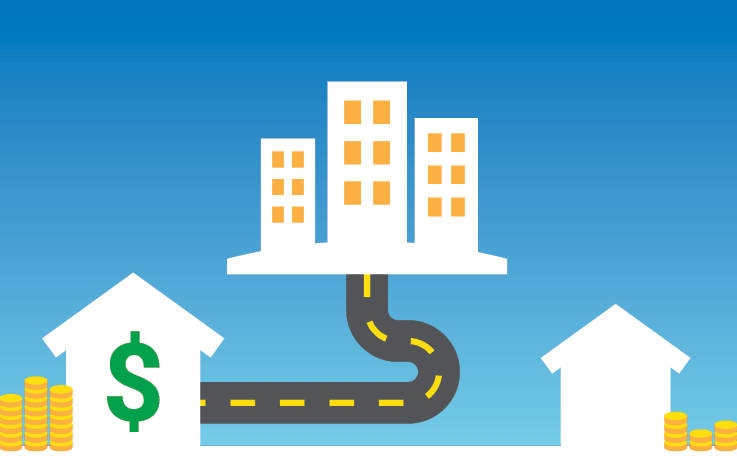
A new or improved highway that connects to economic activity will benefit adjacent parcels. Similar parcels without those connections do not increase in value.
Development impact fees are one-time charges on new development to help municipalities pay for new infrastructure, such as roads, to accommodate the project. In Orange County, CA, the Foothill/Eastern Transportation Corridor and San Joaquin Hills Transportation Corridor Agencies operate four toll roads totaling about 51 miles to provide congestion relief and connectivity. Development impact fees levied on developers of residential and commercial properties were crucial in providing seed capital for the toll roads. The fees now supplement toll revenues to cover debt service payments on the roads.
Tax increment financing (TIF) is a tool that borrows against future increases in real estate values to fund infrastructure improvements. Thousands of cities have designated geographic areas as TIF districts and created improvement plans to enhance existing property values and encourage new development. The BeltLine Tax Allocation District in Atlanta, GA, is developing a multimodal network with multiuse trails, parks, and a light rail system in a 25-year project that is projected to generate $20 billion in economic development, including 30,000 permanent jobs and 48,000 temporary construction jobs.
"Value capture can be a useful and powerful means to capture the economic value created by transportation investment, whether you fund a specific project or program or preservation of the system," said Thay Bishop, senior program advisor for FHWA's Center for Innovative Finance Support and co-leader of the EDC-5 team.
Watch the EDC-5 orientation webinar for an overview of how agencies and communities use value capture to improve infrastructure.
Visit the value capture web page for resources, project profiles, reports, and factsheets.
Contact Stefan Natzke of the FHWA Office of Planning, Environment, and Realty or Thay Bishop of the FHWA Center for Innovative Finance Support for information and technical assistance.
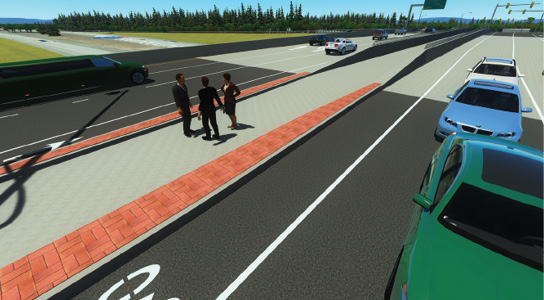
The Washington State Department of Transportation uses 3D modeling to display transportation projects in an immersive natural environment. Credit: Washington State Department of Transportation
When the Washington State Department of Transportation (WSDOT) decided to build its first diverging diamond interchange (DDI), the agency knew an innovative project would require a proactive and equally innovative communication strategy. WSDOT launched a virtual public involvement initiative that used unique visual communication techniques for stakeholder engagement and consent gathering.
An Every Day Counts (EDC) innovation, virtual public involvement uses digital tools to inform people about, and encourage participation in, transportation planning and project development. For the Interstate 5-State Route 510 project, WSDOT used a range of virtual public involvement methods, including project visualizations, videos, project websites, and digital polling on topics such as users' aesthetic preferences, along with meetings and open houses to share knowledge with and engage the public.
The aim was to convey "what's coming and why," said WSDOT Visual Engineering Resource Group (VERG) Manager Kurt Stiles. The challenge, as with many infrastructure projects, was to demonstrate what's in it for drivers, impacted business owners, and other road users.
VERG collaborated with WSDOT's Olympic Region Communications team to determine the communication requirements and goals. A big challenge was that the DDI, an interchange designed to improve safety and reduce congestion, would be the first of its kind in Washington.
Through three-dimensional (3D) computer-aided design modeling, VERG provided an immersive virtual environment to display the project. Shadows can be changed to reflect the time of day. Varied skylines can be inserted and the weather can be adjusted with the season. Trees and other vegetation can be added, too. With powerful natural environment modeling like this, infrastructure projects can be placed in the correct context, which adds tremendous value when explaining the intricacies of the design.
"VERG provides a 'visual voice' and, as such, needs to provide products and productions quickly and effectively," said Stiles. "Our workflows are rooted in civil engineering, but we also work with commercial architects, urban planners, and landscape architects—all those disciplines that bring us the built environment."
VERG used the 3D model to generate many products, including still-image renderings, animations, and shadow studies. "Working with the engineering design software is only half the solution. The remainder is in how those 3D design surfaces are represented, how they are shown in the context of where they will exist once constructed," said Stiles.
The DDI campaign began as a grassroots effort in which the WSDOT communications team sent videos to and held one-on-one meetings with stakeholders and posted videos online. The team also hosted open houses at two schools to discuss how the DDI would impact drivers and pedestrians and show videos illustrating its benefits.
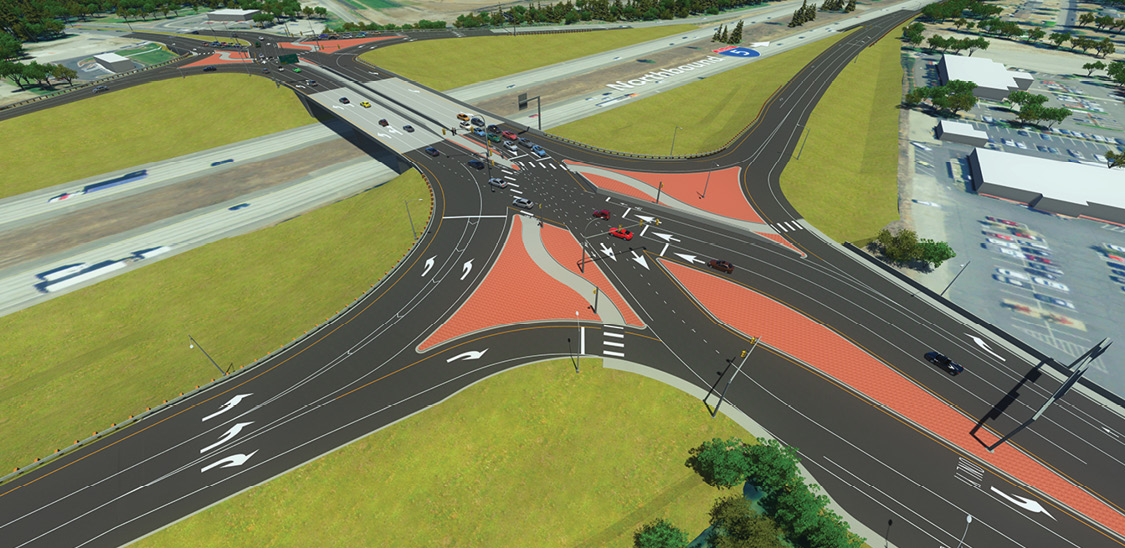
Still-image renderings and other products generated from a 3D model help people visualize Washington State's first diverging diamond interchange. Credit: Washington State Department of Transportation
The "Diverging Diamond Interchange Comes to Washington State" video proved to be a key component of the strategy. With more than a million views, it convinced many cross-sections of public, government, and commercial bodies of the value of retrofitting the interchange into a DDI. Today, after more than a year of showings, the video is still being used to communicate project goals.
Now that the DDI is under construction, VERG is using that 3D model of the project in even more applications. VERG built driving and user scenarios that were deployed through websites and other forms of social media. A new video provides motorists with a driver-seat view of navigating through the detours during construction.
This visual communication process was successful for WSDOT, Stiles said, and provides an example of how other States can incorporate virtual public involvement into projects. "A State DOT can build their own civil stories, keep up with and manage project expectations, and for the most part, lead the conversations that get projects built," he said.
View videos on walking, biking, and driving through the WSDOT DDI.
Visit the VERG website for information on using visual strategies in project development, design, and delivery, and contact Kurt Stiles for insight on developing a DOT visual resource group.
Contact Scott Allen, Jody McCullough, or Harold Peaks of the Federal Highway Administration Office of Planning, Environment, and Realty for information and technical assistance on virtual public involvement.

Geophysical imaging can distinguish material and groundwater variations across a site.
Up to 50 percent of major infrastructure projects experience schedule or cost impacts because of geotechnical issues, which could be avoided by having better information at the planning and development stages. Many of these geotechnical issues are related to the scope and quality of subsurface investigation and site characterization.
In Every Day Counts round five (EDC-5), the Federal Highway Administration is promoting advanced geotechnical methods in exploration (A-GaME), an expanded approach to site investigation that can reduce risk, optimize site characterization, enhance design reliability, and cut construction delays and cost escalations. A-GaME offers proven methodologies and practices that transportation agencies can adopt with confidence based on years of use by their peers.
"The EDC initiative represents an opportunity in geotechnical engineering to accelerate our practice forward," said Ben Rivers, FHWA geotechnical engineer and an A-GaME team leader. "We are sharing mature technologies that offer significant benefits to agencies, but just haven't been widely adopted."
Put simply, the team wants to help transportation agencies bring their A-GaME.
The A-GaME toolbox incorporates site characterization techniques such as cone penetration testing to determine the geotechnical engineering properties of soils, electrical methods to measure the electrical resistivity of the subsurface, measurement while drilling, seismic methods, and optical and acoustic televiewers.
"There is no one single method or combination of methods that will work for all project sites," said Rivers. "Depending on the geologic makeup of a given area and the types of risks that may impact a project, the most appropriate method or methods should be selected for those conditions and project needs."
The EDC-5 team offers support to agencies adopting A-GaME, including training, demonstrations, and peer exchanges on the subsurface exploration methods in the A-GaME toolbox. The team can also provide project-level technical assistance on using the tools to assess and quantify risk and applying results, as well as help establishing program-level objectives and procedures.
Reducing subsurface condition uncertainty helps mitigate design and construction risks. During the design phase, better data allow for less conservative project designs that can save money, Rivers explained. During construction, better data result in fewer claims, change orders, and cost overruns.
"Current site characterization practices leave many gaps in our subsurface data," said Rivers. "The average site may only see 0.01 percent of the volume of material sampled, sensed, or tested. Using A-GaME methods, agencies can dramatically reduce this gap, giving them better data to inform design and construction decisions."
Accelerated project delivery is another A-GaME benefit. Since a significant number of construction delays can be attributed to differing site conditions, well-scoped investigation programs improve decision making and constructability, providing time savings for agencies.
Another benefit is enhanced project quality. Improving confidence in geotechnical characterization reduces unnecessary design conservatism and establishes a more reliable basis for design and construction of foundations and other features impacting the highway system.
The Minnesota Department of Transportation found that using geophysical techniques such as those in the A-GaME toolbox enhance project design and implementation, said Derrick Dasenbrock, geomechanics and load and resistance factor design engineer. "These techniques provide useful information that has improved our sampling program," he said. "We can target our borings. We may be able to have reduced sampling in some areas or maybe denser sampling in areas where things look different."
Dasenbrock cited one example, a simple bridge structure, in which geophysical methods were the only foundation investigation tools used. In this case, an electrical resistivity profile recognized a number of irregular bedrock outcrops. Because of this information, the construction contract allowed for these irregular conditions with the footing design, and ultimately the project was a success. Although relying solely on geophysical methods is not common, this project illustrated that nonconventional approaches can successfully reveal variable conditions cost-effectively while considering specific project risks and construction contracting controls.
Watch the EDC-5 A-GaME orientation webinar for an overview and examples of how agencies use advanced geotechnical methods.
Read "Influence of Geotechnical Investigation and Subsurface Conditions on Claims, Change Orders, and Overruns" to learn how targeted changes in subsurface investigation practices can produce significant results.
Contact Ben Rivers of the FHWA Resource Center or Silas Nichols of the FHWA Office of Infrastructure for information and technical assistance.

Credit: DepositPhotos
A conservative culture in the transportation community frequently impedes the integration of emerging innovations into widespread adoption. At this year's Transportation Research Board (TRB) annual meeting, transportation professionals discussed ways to bridge the gap between research and practice.
"In many instances, the finding of good research is, 'we need more research.' That's okay; that's the discovery process," said Thomas Harman, director of the Federal Highway Administration Center for Accelerating Innovation (CAI). "However, if some of that research isn't going into practice, people start wondering, 'Why are we doing this? Why is this even out there?'"
This discussion started in fall 2018 at FHWA's Every Day Counts (EDC) summits, where transportation leaders made a consistent point: Communication and organizational culture are key to the adoption of new innovations.
"Establishing a culture of innovation is about more than the ability to develop or deploy innovations," said Tony Furst, FHWA chief innovation officer. "It's about a way of thinking. It's about creating an environment where people are encouraged to think differently, to connect the dots, to feel comfortable offering their best ideas."
Changing organizational culture and attitudes to encourage informed risk-taking is an effective way to incorporate innovation into agency practice, said Dr. Cameron Kergaye, research director for the Utah Department of Transportation UDOT, who shared how the State did just that.
"In the 1990s, Utah was preparing for the 2002 Winter Olympics," Kergaye said. "Significant repairs needed to be made to the infrastructure and the typical design-bid-build timeline was 10 years. The director at the time suggested looking at design-build, which was estimated to take only 6.5 years. It took a leap of faith and a lot of courage, but that was the beginning of putting Utah on a path to try things differently."
UDOT is now on the forefront of innovation, quickly moving research into practice on initiatives such as Intelligent Design and Construction (IDC). Using IDC, UDOT provides three-dimensional (3D) modeling designs and associated files to the contractor that can be imported into construction 3D software without the need to validate from a plan set, improving accuracy and saving time.
The ability to communicate is also crucial to innovation adoption, said Jeffrey Zaharewicz, CAI senior advisor. Sharing ideas with other transportation practitioners and engaging the public are key to generating enthusiasm and support for adopting innovations more rapidly.
"Knowing what to say, saying it accurately, and with a message that resonates to the audience are all critical to good communication," he said. "Knowing your audience, whether it's elected officials, media, local municipalities, or the public, is also very important."
The EDC summit and TRB conversations explored ways to strengthen the link between research and practice and encourage collaboration among transportation stakeholders. FHWA used the information gathered during these discussions to develop a new program to help bridge this gap. Accelerating Market Readiness (AMR) focuses on nurturing innovations emerging from research toward market readiness.
AMR complements the EDC program, which accelerates deployment of proven innovations, and the State Transportation Innovation Council network, which is creating a culture of innovation to lead implementation of new technologies and practices in each State. AMR will result in better sharing of performance results to the STIC network and widen the knowledge base on these innovations. It could also help emerging transformative innovations advance to the EDC program.
All of these programs help practitioners take smart risks and move the transportation community forward, Harman said. "FHWA is excited about the launch of the Accelerating Market Readiness program as it will tie into our already-established innovation deployment programs," he said. "Our goal is to accelerate innovations from research into practice, where transportation is transformed through innovation."
Communication is key to getting innovations into widespread practice. The Oklahoma Department of Transportation (ODOT) had a success story to tell on deployment of high-friction surface treatments (HFST) to decrease fatalities and prevent crashes. In the 3 years after ODOT applied HFST at three Mayes County locations, two crashes and no severe injuries occurred, compared to 26 crashes and four severe injuries in the 5 years before treatment. For an HFST project on Interstates 40 and 44 in Oklahoma City, 11 crashes and no severe injuries occurred in the 1.5 years after treatment, compared to 159 crashes and eight severe injuries in the 5 years before treatment. ODOT shared its successes in a report and news release, part of an outreach toolkit to accelerate HFST deployment the agency developed with State Transportation Innovation Council (STIC) Incentive funds.
The Rhode Island Department of Transportation's (RIDOT) Apponaug Circulator project converted five intersections to roundabouts and realigned roadways to improve safety and redirect traffic from a historic village center to major roads. As a result, the number of vehicles going through the Apponaug village center dropped from 25,000 to 6,800 a day, reducing traffic congestion and making the area more pedestrian friendly. The Apponaug Circulator is one of about 20 roundabouts RIDOT has constructed in place of traditional intersections to enhance safety.
The Virginia Department of Transportation (VDOT) used STIC Incentive funds on a wildlife fencing project to reduce collisions and connect wildlife habitats. The project constructed fencing along two segments of Interstate 64 near Charlottesville to guide deer and other wildlife to underpasses and prevent them from crossing the highway. Before the fencing was installed, an average of about 8 deer-vehicle collisions occurred each year along the 1-mile interstate segments. Since the installations were completed, one deer collision has occurred and use of the underpasses by wildlife has increased significantly. The project set the standard for design and placement of wildlife fencing along Virginia underpasses, and VDOT plans to identify other suitable locations.
The Federal Highway Administration's updated Pedestrian Safety Guide and Countermeasure Selection System (PEDSAFE) offers an interactive way to identify safe transportation for every pedestrian (STEP) countermeasures. Here's how it works:
In PEDSAFE's Countermeasure Selection Tool, users can choose "improve safety at uncontrolled crossings."
The tool leads users through a list of questions linked to the "FHWA Guide for Improving Pedestrian Safety at Uncontrolled Crossing Locations."
The tool returns a list of countermeasures suitable to the specified roadway conditions, and each countermeasure links to a page in PEDSAFE with details on costs, design considerations, and installation examples across the country.
Contact Rebecca Crowe of the FHWA Office of Safety for information.
Every Day Counts: On-Ramp to Innovation describes the 10 technologies and practices FHWA is promoting in EDC rtound five. The report summarizes the deployment status of the innovations at the beginning of 2019 and the goals States set to broaden their adoption by the end of 2020.
Innovator, published by the FHWA Center for Accelerating Innovation, advances implementation of innovative technologies and accelerated project delivery methods in the highway industry. Its audience is transportation professionals in highway agencies, trade and research groups, academia and the private sector, and the driving public.
Elaine L. Chao, Secretary, U.S. DOT
Nicole R. Nason, Administrator, FHWA
Thomas Harman, Director
Jeffrey Zaharewicz, Senior Advisor
Ewa Flom, Program Coordinator
Sara Lowry, Program Coordinator
Fawn Thompson, Program Coordinator
Julie Zirlin, Program Manager
Nichole Causey, Marketing Specialist
Ellen Schweppe, Managing Editor
James Cline, Jr., Designer
Pat Holcombe, Designer
Rodney Walker, Designer
Email reprint requests to Nichole Causey
View Innovator archive.